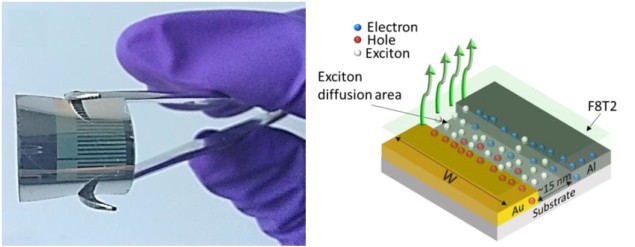Polymer LEDs go nano
21 Sep 2018 Anna Demming
 A nanoscale polymer LED device fabricated on a polyethylene terephthalate (PET) substrate using adhesion lithography.
A nanoscale polymer LED device fabricated on a polyethylene terephthalate (PET) substrate using adhesion lithography.
Potential applications of nanoscale polymer LEDS abound, but efficient nanofabrication methods to produce them remain limited. Reporting in the first issue of the Journal of Physics Materials, Thomas D. Anthopoulos and colleagues at Imperial College London and the National Physical Laboratory in the UK, and King Abdullah University of Science and Technology (KAUST) in Saudi Arabia show how the recently developed adhesion lithography technique enables the versatility and precision to produce high-performing polymer green-light-emitting diodes with an inter-electrode distance of under 15 nm and an aspect ratio of up to 106.
As well as potential light sources for scanning near-field optical microscopes and nanoscale photopatterning, the efficient dissipation of Joule heating allows nanoscale polymer LEDs to achieve higher current densities that may eventually enable electrically pumped organic lasers. Yet as Anthopoulos and co-authors point out in their report, “Further progress has, however, been hindered by manufacturing challenges, as shadow masking and conventional photolithography cannot produce nanometre-sized electrode features between different metals, while e-beam lithography is not suitable for upscale while it is often limited to a single electrode material.”

Adhesion lithography brings versatility
Alongside researchers at Imperial College London and KAUST, Anthopoulos described how adhesion lithography could produce nanogaps less than 15 nm apart between electrodes of different materials in Nature communications in 2014 . The approach involves depositing a self-assembled molecular layer on a pre-patterned metal layer, thereby weakening its adhesion to a subsequently deposited metal layer. They then exploited the weakened adhesion to remove the second metal layer from the first with tape, leaving the second layer only in the prepatterned gaps of the first metal, and a nanogap between the two metals once the self-assembled molecular layer is removed.
Anthopoulos and colleagues now apply the technique to fabricate nanoscale polymer LEDs with one gold and one aluminium electrode and the light emitting polymer poly(9,9-dioctylfluorene-alt-bithiophene) (F8T2). The ability to fabricate the LED with different metal electrodes allows them to engineer preferential hole injection from the gold Fermi level to the F8T2, since the potential barrier is lower than at the interface between F8T2 and aluminium.
Redshifts in the photoluminescence specra compared with F8T2 on quartz indicate the effects of nanoconfinement of the polymer in the nanogap. They also demonstrate improved light output from the LED by increasing the aspect ratio, as well as devices fabricated on plastic and glass.
“To the best of our knowledge this is the first example of a flexible nano-PLED fabricated on a plastic substrate. The consistency of these results with the ones obtained on glass substrates demonstrate the versatility of a-Lith to create large size nano-gap devices on a variety of substrate materials,” say Anthopoulos and co-authors in the report.READ MORE

ICREA Professor Stephan Roche, who is Editor in Chief of the Journal of Phyiscs: Materials, and not involved with the current research highlights the significance of demonstrating the fabrication technique on plastic and glass. “If you base your technology on silicon only and you want to miniaturize, the cost increases more and more as you narrow down the size of the device. In this case glass and plastics are very common materials, the cost is very low and their technology is chemically driven so it doesn’t really add an additional cost. Instead it brings versatility, complexity in terms of the possible architectures, and it brings a light source at the nanoscale – that’s a new dimension for a lot of applications.”
Full details are reported in Journal of Physics: Materials.
21/9/2018 FROM PHYSICSWORLD.COM
Δεν υπάρχουν σχόλια:
Δημοσίευση σχολίου